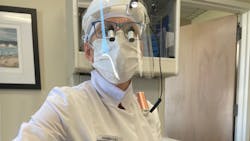Proper 'pandemic ergonomics' leads to better clinician and patient experiences
The country was introduced to social distancing just one year ago. People have become aware of their proximity to others in the effort to limit the spread of disease. However, with the skepticism surrounding scientific information and government regulations, the idea of social distancing has become a point of contention for many because of cultural factors such as politics, individualism, and autonomy.1 The dissonance between scientific information and the “disinformation without any scientific evidence” is a problem.2 Many dental professionals agree that this dissonance is a problem between us and our patients.
Regardless of all the opinions, we have a responsibility to make dental appointments as comfortable as possible for everyone. Many hygienists are picking up extra shifts to cover for coworkers who become sick, must change their schedules, or quit. Some hygienists worry about their exposure to SARS-CoV-2 because of their family members who are at high risk. Many hygienists are choosing to hand scale regularly to reduce aerosol production. Evidence suggests that hand and ultrasonic instrumentation are equally effective in removing plaque and calculus deposits.3,4 Patients are expressing even more anxiety about going to the dentist than before the pandemic because of their proximity to us and other patients.5 With many of us using hand instruments more often, spending more hours in the chair, and trying to keep us and patients from being exposed to SARS-CoV-2, ergonomics may be more important now than ever before.
Experts agree that the nature of dental care (aerosol generation and closeness to patients) is something that practice owners need to consider when planning for the future and allocating financial resources for their employees.6 However, research from the American Dental Association predicts that spending on dental care in the United States could decrease by up to 66% in 2020 and 32% in 2021, a difficult blow to dental practices.7
With many offices trying to stay afloat and recover from last year’s closure, it’s possible that many will not be able to afford replacement instruments or updated equipment. It’s becoming common for hygienists to purchase their own instruments, chairs, loupes, and ultrasonic equipment to ensure they have the supplies they need to prevent strain and musculoskeletal injuries. They consider these expenses an investment in a longer and healthier career. Many hygienists are also trying to follow the ADA’s recommendation to reduce aerosols as much as possible through the use of hand instrumentation and high-speed suction.8
As hand instruments become our workhorses, it’s important to keep them sharp. Dull instruments require tighter grip, more lateral pressure, and often lead to the wrist leaving its neutral position.9 Scaling with dull instruments also takes longer. In my experience, those patients with anxiety about COVID-19 do whatever they can to get out of the office as quickly as possible. Patients often ask me to postpone radiographs, periodontal charting, and even fluoride because they want to get out of the office. Speed and efficiency of appointments is a priority for patients and sharp instruments help that happen.
Virtual learning, unexpected closures, and the need for childcare have wreaked havoc on hygienists’ schedules. Many offices have had a hard time finding subs, part-time or full-time, and are leaning on their current hygienists to fill in. While this provides additional income and experience, covering extra shifts for an extended period of time increases the risk for musculoskeletal injuries, especially on clinicians who do not practice ideal ergonomics.10 Physical pain in addition to psychological stress can create the perfect storm for burnout. Therefore, it’s important for clinicians to listen to their bodies. Stretching, exercise, massage, chiropractic adjustments, and days off provide rest and healing time to ward off musculoskeletal injury.11
Ergonomic measures
Proper posture offers additional protection from contamination and comfort for both clinicians and patients. Graduating dental students report that the most common areas of pain are the neck and lower back.12 Not surprisingly, this aligns with findings that say forward head and neck flexion and trunk inclination and rotation are the ergonomic gaffes most dental professionals commit.11 The flexion of the neck angles the head to allow direct vision into the patient's mouth, and the extension and rotation of the back provides similar results. Unfortunately, these movements increase the likelihood of unnecessary patient-to-clinician contact.
Keeping the spine as straight as possible while using the mirror for indirect vision provides ergonomic comfort and can help patients feel more comfortable being close—but not too close—to the clinician. Creating space whenever possible is key to helping apprehensive patients feel confident that a clinician is taking infection control and the Centers for Disease Control and Prevention guidelines seriously.
Proper ergonomics during the pandemic will help patients and clinicians feel comfortable in the dental office. While some patients feel distrustful of the guidelines that have been recommended by government agencies and the scientific community, a great number of them are deeply concerned about the risk of going to the dentist during the pandemic. Similarly, many hygienists (including myself) have felt the burden and uncertainty of working in such a high-risk environment. Our bodies and minds are tired. Let us remember that proper ergonomics can help our patients and us feel more comfortable and have a better experience in the dental office.
References
- Huynh TLD. Does culture matter social distancing under the COVID-19 pandemic? Saf Sci. 2020;130(10). doi:10.1016/j.ssci.2020.104872
- Everett JAC, Colombatto C, Chituc V, Brady WJ, Crockett M. The effectiveness of moral messages on public health behavioral intentions during the COVID-19 pandemic. PsyArXiv. Preprint posted online March 20, 2020. Edited September 23, 2020. doi:10.31234/osf.io/9yqs8\
- Ge ZY, Yang LM, Xia JJ, Fu XH, Zhang YZ. Possible aerosol transmission of COVID-19 and special precautions in dentistry. J Zhejiang Univ Sci B. 2020;21(5):361-368. doi:10.1631/jzus.B201001
- Krishna R, De Stefano JA. Ultrasonic vs. hand instrumentation in periodontal therapy: clinical outcomes. Periodontol 2000. 2016 ;71(1):113-27. doi: 10.1111/prd.1211
- Cotrin P, Peloso RM, Oliveira RC, et al. Impact of coronavirus pandemic in appointments and anxiety/concerns of patients regarding orthodontic treatment. Orthod Craniofac Res. 2020;23(4):455-461. doi:10.1111/ocr.12395
- Gaffar B, Alhumaid J, Alhareky M, Alonaizan F, Almas K. Dental facilities during the new corona outbreak: a SWOT analysis. Risk Manag Healthc Policy. 2020;13:1343-1352. doi:10.2147/RMHP.S265998
- Nasseh K, Vujicic M. Modeling the impact of COVID-19 on U.S. dental spending. American Dental Association Health Policy Institute Research Brief. April 2020. https://www.ada.org/~/media/ADA/Science%20and%20Research/HPI/Files/HPIBrief_0420_1.pdf?la=en
- Summary of ADA guidance during the COVID-19 crisis. October 2020. American Dental Association. https://success.ada.org/~/media/CPS/Files/COVID/COVID-19_Int_Guidance_Summary.pdf
- McGlynn D. Dull instruments and hand injury to the hygienist: There's a connection. December 18, 2019. Accessed December 29, 2020. DentistryIQ. https://www.dentistryiq.com/dental-hygiene/ergonomics/article/14073741/ergonomics-and-sharpening-the-connection-between-using-dull-instruments-and-hand-injury-to-the-hygienist
- 1Gupta A, Bhat M, Mohammed T, Bansal N, Gupta G. Ergonomics in dentistry. Int J Clin Pediatr Dent. 2014;7(1):30-34. doi:10.5005/jp-journals-10005-1229
- De Sio S, Traversini V, Rinaldo F, et al. Ergonomic risk and preventive measures of musculoskeletal disorders in the dentistry environment: an umbrella review. PeerJ. 2018;6:e4154. doi:10.7717/peerj.4154
- Ng A, Hayes MJ, Polster A. Musculoskeletal disorders and working posture among dental and oral health students. Healthcare Basel. 2016;4(1):13. doi:10.3390/healthcare4010013
Rebecca “Becca” Neilson, BS, RDH, grew up in Provo, Utah. She graduated from Brigham Young University in 2014 with a BS in biology and Indiana University in 2020 with a BS in dental hygiene. She practices in a private dental office in Elkhart, Indiana. Neilson thrives off of interpersonal relationships and finds satisfaction in helping others learn. You can reach her at [email protected].
About the Author
Rebecca “Becca” Neilson, BS, RDH
Rebecca “Becca” Neilson, BS, RDH, grew up in Provo, Utah. She graduated from Brigham Young University in 2014 with a BS in biology and Indiana University in 2020 with a BS in dental hygiene. She practices in a private dental office in Elkhart, Indiana. Neilson thrives off of interpersonal relationships and finds satisfaction in helping others learn. You can reach her at [email protected].

